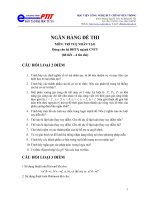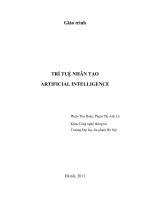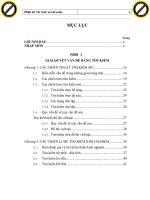Trí tuệ nhân tạo chapter11 machine learning
Bạn đang xem bản rút gọn của tài liệu. Xem và tải ngay bản đầy đủ của tài liệu tại đây (336.58 KB, 71 trang )
Machine Learning
Chapter 11
CuuDuongThanCong.com
/>
Machine Learning
• What is learning?
Cao Hoang Tru
CSE Faculty - HCMUT
CuuDuongThanCong.com
2
15 November 2011
/>
Machine Learning
• What is learning?
• “That is what learning is. You suddenly understand
something you've understood all your life, but in a
new way.”
(Doris Lessing – 2007 Nobel Prize in Literature)
Cao Hoang Tru
CSE Faculty - HCMUT
CuuDuongThanCong.com
3
15 November 2011
/>
Machine Learning
• Arthur Samuel (1959):
"Field of study that gives computers the ability to
learn without being explicitly programmed”.
• Tom Mitchell (1997):
"A computer program is said to learn from experience
E with respect to some class of tasks T and
performance measure P, if its performance at tasks in
T, as measured by P, improves with experience E”.
Cao Hoang Tru
CSE Faculty - HCMUT
CuuDuongThanCong.com
4
15 November 2011
/>
Machine Learning
• How to construct programs that automatically improve
with experience.
Cao Hoang Tru
CSE Faculty - HCMUT
CuuDuongThanCong.com
5
15 November 2011
/>
Machine Learning
• How to construct programs that automatically improve
with experience.
• Learning problem:
– Task T
– Performance measure P
– Training experience E
Cao Hoang Tru
CSE Faculty - HCMUT
CuuDuongThanCong.com
6
15 November 2011
/>
Machine Learning
• Chess game:
– Task T: playing chess games
– Performance measure P: percent of games won against
opponents
– Training experience E: playing practice games againts itself
Cao Hoang Tru
CSE Faculty - HCMUT
CuuDuongThanCong.com
7
15 November 2011
/>
Machine Learning
• Handwriting recognition:
– Task T: recognizing and classifying handwritten words
– Performance measure P: percent of words correctly
classified
– Training experience E: handwritten words with given
classifications
Cao Hoang Tru
CSE Faculty - HCMUT
CuuDuongThanCong.com
8
15 November 2011
/>
Example
Experience
Example
GRAY?
MAMMAL? LARGE? VEGETARIAN? WILD?
Elephant
1
+
+
+
+
+
+
2
+
+
+
-
+
+
3
+
+
-
+
+
- (Mouse)
4
-
+
+
+
+
- (Giraffe)
5
+
-
+
-
+
- (Dinosaur)
6
+
+
+
+
-
+
Prediction
7
+
+
+
-
+
?
8
+
-
+
-
+
?
9
+
+
+
-
-
?
Cao Hoang Tru
CSE Faculty - HCMUT
CuuDuongThanCong.com
9
15 November 2011
/>
Example
Experience
Example
Sky
AirTemp
1
Sunny
Warm
Normal
Strong
Warm
Same
Yes
2
Sunny
Warm
High
Strong
Warm
Same
Yes
3
Rainy
Cold
High
Strong
Warm
Change
No
4
Sunny
Warm
High
Strong
Cool
Change
Yes
Low
Weak
Prediction
Humidity
Wind
Water
Forecast
EnjoySport
5
Rainy
Cold
High
Strong
Warm
Change
?
6
Sunny
Warm
Normal
Strong
Warm
Same
?
7
Sunny
Warm
Low
Strong
Cool
Same
?
Cao Hoang Tru
CSE Faculty - HCMUT
CuuDuongThanCong.com
10
15 November 2011
/>
Machine Learning
Training
Testing
Applying
Training
Data
Testing
Data
Real
Data
Cao Hoang Tru
CSE Faculty - HCMUT
CuuDuongThanCong.com
11
15 November 2011
/>
Machine Learning
• What is learning?
Cao Hoang Tru
CSE Faculty - HCMUT
CuuDuongThanCong.com
12
15 November 2011
/>
Machine Learning
• What is learning?
Experience
Cao Hoang Tru
CSE Faculty - HCMUT
CuuDuongThanCong.com
Learner
Hypothesis
13
15 November 2011
/>
Machine Learning
• Learning is an (endless) generalization or induction
process.
Cao Hoang Tru
CSE Faculty - HCMUT
CuuDuongThanCong.com
14
15 November 2011
/>
Machine Learning
• Supervised learning: the learner (learning algorithm)
are trained on labelled examples, i.e., input where the
desired output is known.
• Unsupervised learning: the learner operates on
unlabelled examples, i.e., input where the desired
output is unknown.
Cao Hoang Tru
CSE Faculty - HCMUT
CuuDuongThanCong.com
15
15 November 2011
/>
Concept Learning
• Inferring a boolean-valued function from training
examples of its input (instances) and output
(classifications).
Cao Hoang Tru
CSE Faculty - HCMUT
CuuDuongThanCong.com
16
15 November 2011
/>
Concept Learning
• Learning problem:
– Target concept: a subset of the set of instances X
c: X → {0, 1}
– Target function:
Sky × AirTemp × Humidity × Wind × Water × Forecast → {0, 1}
– Hypothesis:
Characteristics of all instances of the concept to be learned
≡ Constraints on instance attributes
h: X → {0, 1}
Cao Hoang Tru
CSE Faculty - HCMUT
CuuDuongThanCong.com
17
15 November 2011
/>
Concept Learning
• Satisfaction:
h(x) = 1 iff x satisfies all the constraints of h
h(x) = 0 otherwsie
• Consistency:
h(x) = c(x) for every instance x of the training examples
• Correctness:
h(x) = c(x) for every instance x of X
Cao Hoang Tru
CSE Faculty - HCMUT
CuuDuongThanCong.com
18
15 November 2011
/>
Concept Learning
• How to represent a hypothesis?
Cao Hoang Tru
CSE Faculty - HCMUT
CuuDuongThanCong.com
19
15 November 2011
/>
Concept Learning
• Hypothesis representation (constraints on instance attributes):
<Sky, AirTemp, Humidity, Wind, Water, Forecast>
– ?: any value is acceptable
– single required value
– ∅: no value is acceptable
• Example:
h1 = <Sunny, ?, ?, Strong, ? , ?>
Cao Hoang Tru
CSE Faculty - HCMUT
CuuDuongThanCong.com
20
15 November 2011
/>
Concept Learning
• General-to-specific ordering of hypotheses:
hj ≥g hk iff ∀x∈X: hk(x) = 1 ⇒ hj(x) = 1
Specific
h1 = <Sunny, ?, ?, Strong, ? , ?>
h1
h3
Lattice
(Partial order)
General
Cao Hoang Tru
CSE Faculty - HCMUT
CuuDuongThanCong.com
h2 =
?
, ? , ?>
h3 =
?
, Cool, ?>
h2
H
21
15 November 2011
/>
Concept Learning
Example
Sky
AirTemp
Humidity
Wind
Water
Forecast
EnjoySport
1
Sunny
Warm
Normal
Strong
Warm
Same
Yes
2
Sunny
Warm
High
Strong
Warm
Same
Yes
3
Rainy
Cold
High
Strong
Warm
Change
No
4
Sunny
Warm
High
Strong
Cool
Change
Yes
What is a hypothesis that is consistent with the
training examples?
h=<_,_,_,_,_,_>
Cao Hoang Tru
CSE Faculty - HCMUT
CuuDuongThanCong.com
22
15 November 2011
/>
Concept Learning
Example
Sky
AirTemp
Humidity
Wind
Water
Forecast
EnjoySport
1
Sunny
Warm
Normal
Strong
Warm
Same
Yes
2
Sunny
Warm
High
Strong
Warm
Same
Yes
3
Rainy
Cold
High
Strong
Warm
Change
No
4
Sunny
Warm
High
Strong
Cool
Change
Yes
What is the most specific hypothesis that is consistent
with the training examples?
h=<_,_,_,_,_,_>
Cao Hoang Tru
CSE Faculty - HCMUT
CuuDuongThanCong.com
23
15 November 2011
/>
FIND-S
Example
Sky
AirTemp
Humidity
Wind
Water
Forecast
EnjoySport
1
Sunny
Warm
Normal
Strong
Warm
Same
Yes
2
Sunny
Warm
High
Strong
Warm
Same
Yes
3
Rainy
Cold
High
Strong
Warm
Change
No
4
Sunny
Warm
High
Strong
Cool
Change
Yes
h=< ∅ ,
∅ ,
∅ ,
∅ , ∅ ,
∅ >
h = <Sunny, Warm, Normal, Strong, Warm, Same>
h =
?
, Strong, Warm, Same>
h =
?
, Strong,
Cao Hoang Tru
CSE Faculty - HCMUT
CuuDuongThanCong.com
? ,
? >
24
15 November 2011
/>
FIND-S
• Initialize h to the most specific hypothesis in H:
• For each positive training instance x:
For each attribute constraint ai in h:
If the constraint is not satisfied by x
Then replace ai by the next more general
constraint satisfied by x
• Output hypothesis h
Cao Hoang Tru
CSE Faculty - HCMUT
CuuDuongThanCong.com
25
15 November 2011
/>









